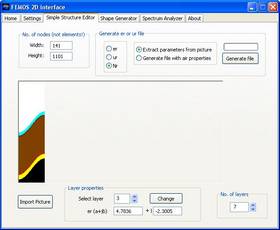^
Overview

Optical simulator - FEMOS 2D is the tool dedicated to study optoelectronic devices, esspecially the thin-film solar cells and is based on Finite Element Method.
Key features
- Fully automated and easy to use (no knowledge needed about modelling), automatically calculate the solution for the TE and TM field.
- Using low reflection boundary condition.
- Utilizing multicore processors for better performance.
- Extremely memory efficient, our own implementation of iterative solvers CG and FGMRES methods with SSOR precondition.
- Window and Linux version of the program are possible.
- Built in material parameters, other custom materials can be easilly added.
- Powerful graphical tool based on OpenGL for showing and analysing the optical behavior inside the structure.
Trial version
By request!
Video demo
FEMOS 2D video link
^
Description
Applicability
FEMOS 2D can be used for simulating any kind of optical simulations. However, the interface and the program is designed in the way it is optimized to simulate the thin-film solar cells, and to characterize different surface morphologies. The wavelength dependent analysis (spectral analysis) is the main advantage of the simulator, it calculates the absorptance, transmittance and reflectance from the solar cell. From the absorptances generation rate profile is calculated, which can be used as input for electrical simulations of solar cells. However, the program is not limited to solar cells, thus different parameters are calculated such as: electric field, flux, absorptance, ...
Model
Model is based on Finite Element method, which is much more appropriate method compared to other methods, e.g. FDTD. The spectral response is calculated at different wavelengths with measured material parameters. It is easy to study the advanced structures utilizing plasmonic effect, photonic crystals, ... The model is implemented in c/c++ compiled with the latest gcc, thus much higher response and speed is achieved even for large models exceeding 1 million degrees of freedom.
^
References
Publications
Original scientific article
- ČAMPA, Andrej, KRČ, Janez, SMOLE, Franc, TOPIČ, Marko. Potential of diffraction gratings for implementation as a metal back reflector in thin-film silicon solar cells. Thin solid films. Aug. 2008, vol. 516, no. 20
- ČAMPA, Andrej, KRČ, Janez, TOPIČ, Marko. Two-dimensional optical model for simulating periodic optical structures in thin-film solar cells = Dvo-dimenzionalni optični model za simulacijo periodičnih optičnih struktur v tankoplastnih sončnih celicah. Inf. MIDEM, mar. 2008, Vol.38, No. 1
- ČAMPA, Andrej, KRČ, Janez, TOPIČ, Marko. Analysis and optimisation of microcrystalline silicon solar cells with periodic sinusoidal textured interfaces by two-dimensional optical simulations. J. appl. phys., 2009, vol. 105, no. 8
- ČAMPA, Andrej, ISABELLA, Olindo, ERVEN, Rob van, PEETERS, Patrick, BORG, Herman, KRČ, Janez, TOPIČ, Marko, ZEMAN, Miro. Optimal design of periodic surface texture for thin-film a-Si:H solar cells. Prog. photovolt., May 2010, vol. 18, no. 3
scientific conference contribution
- LIPOVŠEK, Benjamin, CVEK, Matjaž, ČAMPA, Andrej, KRČ, Janez, TOPIČ, Marko. Analysis and optimisation of periodic interface textures in thin-film silicon solar cells. V: SANTI, G. F. de (ur.), OSSENBRINK, Heinz A. (ur.), HELM, P. (ur.). 25th European Photovoltaic Solar Energy Conference / 5th World Conference on Photovoltaic Energy Conversion, Valencia, Spain, 6-10 September 2010
- ISABELLA, Olindo, ČAMPA, Andrej, HEIJNA, M. C. R., SOPPE, W., ERVEN, Rob van, FRANKEN, R. H., BORG, H., ZEMAN, Miro. Diffraction gratings for light trapping in thin-film silicon solar cells. V: 23rd European Photovoltaic Solar Energy Conference, Valencia, Spain, 1-5 September 2008



